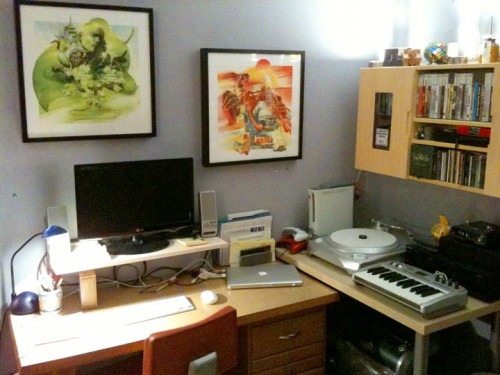 Last week I ripped on longwinded, narcissistic douchebag tech bloggers, indirectly ripping on the fandango that is (or appears to be) the JooJoo along the way. I can be a bit of a snark at times, and I take pleasure in ripping on things. But it’s a hollow pleasure, and it leaves a bad taste in my mouth.
Last week I ripped on longwinded, narcissistic douchebag tech bloggers, indirectly ripping on the fandango that is (or appears to be) the JooJoo along the way. I can be a bit of a snark at times, and I take pleasure in ripping on things. But it’s a hollow pleasure, and it leaves a bad taste in my mouth.
On the other hand, I do occasionally take the much rarer pleasure of delighting in something really cool… in Steve Jobs’ words, from the days of the original Macintosh project, something insanely great. But those “insanely great” things don’t come along very often. And along the way, there are a lot of false alarms. Many things claim to be the “next big thing” (even if big means being… “little”)… some even go so far as to claim to be… “it.” But in the end, they just turn out to be the Segway. No thanks.
Netbooks have been the “next big (little) thing” for a while now, and although I do see their appeal, they all just seem like cheap, underpowered, too-small laptops. Building a tiny device and then putting Windows XP on it is not going to change the world. Yawn.
But then a few weeks ago I heard about another next big thing, called the litl. Part of the hubbub surrounded the fact that there were some heavy hitters in the design world involved in its creation. This was not just another tiny computer made out of cheap plastic, running an 8-year-old OS from Microsoft. This was something different.
But still, it seemed kind of silly to me. Why would I want a netbook that stored all of its data in “the cloud” (especially given some of the notorious problems “the cloud” has had lately), and especially why would I want one that doubles as a digital photo frame. Yawn… maybe.
Tonight I was reading Slashdot when… of all things… a banner ad caught my attention. I’ve clicked on banner ads maybe 3 times in my entire life, but this was a banner ad for the litl, and it intrigued me. So I clicked, and began to discover that there may, in fact, be some really cool things about the litl that make it worth some serious attention. There’s a litl blog where you can read some press the litl’s been getting, along with some background info on (and from) the team, including some pretty interesting videos. My curiosity is piqued. I’d love to see one of these things in person. I think, as superficial as it may sound, whether or not I would ultimately be interested in a netbook of any kind is determined largely by how cheap the plastic it’s made out of feels. It’s kind of hard to tell from the videos, but one thing I can tell is that a lot of care and love went into creating this thing, and it’s unlike any netbook out there today. Have a look at these videos to see what I mean:
The card concept is cool. This is truly a revolutionary interface… it’s what the JooJoo dreams of being.
I’m still hesitant about having all of my data in the cloud — does this mean you have to be connected to WiFi to be able to do… well… anything with the litl? I didn’t see anything about 3G access. And what happens if there’s a catastrophic server failure? Does litl (the device) become a fancy paperweight while litl (the company) scrambles to get things back up and running? What about privacy and security? (I’d be surprised if these questions aren’t addressed somewhere on their site; I just didn’t encounter those answers yet. And they’re questions any sensible potential customer is going to want answered before they hand over their money.)
Not quite an Apple package design, but close. And this looks like it might actually be made out of post-consumer recycled materials. That’s a plus. I like the overall attention to detail. The people who made the litl love their work, and they want you to love it, too.
Will I get one? I’m not exactly itching to drop $699 on this, or anything else, at the moment. I’d like to see it priced at $499 or less. I’d also like to, you know, see it. In person, I mean. I like the money-back guarantee, but I still think they need to have some retail presence for the litl to really take off.
Consider me impressed. I think this has the potential to be something “insanely great.” I’ll be interested in seeing where this leads… and, if the long-rumored Apple foray into this niche actually happens, how the litl will affect it, or not, and vice versa.
On the other hand, maybe I’m just being seduced by decadent marketing.







